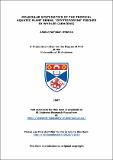Files in this item
Molecular systematics of the tropical aquatic plant genus, 'Cryptocoryne' Fischer ex Wydler (Araceae)
Item metadata
| dc.contributor.advisor | Abbott, Richard J. | |
| dc.contributor.author | Othman, Ahmad Sofiman | |
| dc.coverage.spatial | 223p. | en_US |
| dc.date.accessioned | 2017-06-21T12:38:54Z | |
| dc.date.available | 2017-06-21T12:38:54Z | |
| dc.date.issued | 1997 | |
| dc.identifier | uk.bl.ethos.528395 | |
| dc.identifier.uri | https://hdl.handle.net/10023/11044 | |
| dc.description.abstract | Cryptocoryne is an aquatic plant genus occurring in tropical Asia. A number of species within the genus are widely used as foliage plants in tropical fish aquaria. The taxonomy and systematics of the genus have been based in the past on morphological characteristics, geographical distribution and chromosome number. The aim of this research was to construct a phylogeny for the genus based on molecular variation and to establish relationships among species in areas of different geographical origin and of different chromosome base number. A phylogeny constructed from sequence variation of the internal transcribed spacer (ITS) region of nuclear ribosomal DNA, separated the genus into three distinct clades reflecting a strong geographical pattern. One clade consisted of species from mainland Asia, another was comprised of species from Sri Lanka while the third clade consisted of species from Malesia. However, these clades did not reflect rigidly the geographical origin of areas in which the genus is distributed. The ITS phylogeny also indicated that species with a base chromosome number of x=14 are derived from x=18 stock, and that x=l1 has arisen twice in the course of the evolution of the genus. The origin of other chromosome base numbers, i.e. x=15 and x=17, was not clearly resolved. A phylogeny based on chloroplast (cp) DNA sequence variation was similar in topology to that of the ITS phylogeny although resolution of species relationships was not so good. Phenograms produced from RAPD variation gave a better resolution of affinities among closely related Cryptocoryne species from Sri Lanka, but differed in overall topology from the phylogenies obtained from ITS and cpDNA sequence variation. Compelling evidence for the origin of the hybrid C. x willisii from C. walkerii and C. parva was obtained from the RAPD analysis, in that C. x willisii exhibited an additive RAPD profile which combined the profiles of its two putative parents. C. x willisii also contained an ITS sequence similar to that of C. walkeri in some accessions examined, and a cpDNA sequence similar to C. walkeri and its close relative C. beckettii. | en_US |
| dc.language.iso | en | en_US |
| dc.publisher | University of St Andrews | |
| dc.subject.lcc | QK495.A685O8 | |
| dc.subject.lcsh | Araceae--Classification--Molecular aspects | en |
| dc.title | Molecular systematics of the tropical aquatic plant genus, 'Cryptocoryne' Fischer ex Wydler (Araceae) | en_US |
| dc.type | Thesis | en_US |
| dc.type.qualificationlevel | Doctoral | en_US |
| dc.type.qualificationname | PhD Doctor of Philosophy | en_US |
| dc.publisher.institution | The University of St Andrews | en_US |
This item appears in the following Collection(s)
Items in the St Andrews Research Repository are protected by copyright, with all rights reserved, unless otherwise indicated.

